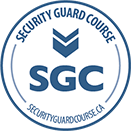On July 18, 2025, a 26-year old male was arrested for theft by security guards at a Sault Ste. Marie business. This in itself is not overly news worthy. Private security guards have been arresting people for theft for decades. What makes this situation noteworthy is that during the arrest, one of the security guards was bitten by the suspect. The man now faces charges of theft AND assault.
For many working in the security industry, particularly in retail loss prevention, this story resonates. Those working in this role know that the job comes with a degree of risk, and are trained to manage it safely. However, few anticipate violence that includes being bitten by another adult human being. Unfortunately, this guard is not the first, nor will they be the last to be bitten in the line of duty. The fact that this incident made the news provides us with an important opportunity to reflect on the risks associated with making arrests in the course of a security guard’s duties.
In this post, we will take a look at the incident, break down the key takeaways, and offer some guidance on how security guards can be prepared for unpredictable situations, responding in ways to keep themselves safe, professional, and within their legal authorities.
The Sault Ste. Marie Incident
According to reports from CTV News, the incident occurred when a man allegedly attempted to steal items from a commercial business. Security personnel confronted the subject to make a lawful arrest. During the physical apprehension, the suspect bit one of the security guards, leading to “minor injuries”. The guards were able to detain the suspect, who was subsequently turned over to the police.
While it may sound unusual, biting is not an uncommon occurrence in close-contact engagements. For instance, security guards working in healthcare have more experience with this behaviour than most, given the frequency in which they are required to apply physical restraints to violent patients. When people feel trapped, especially if their arms and legs are restricted, they will resort to spitting and biting as a defence.
The news article referred to the guard’s injuries as “minor”, however a biting injury is anything but. The physical injury may be small in size, but there is a potential for infection, exposure to many diseases, and psychological consequences for the guard who was bitten.
The Possibility of Violence is Real
Many people assume that violence only comes from angry, aggressive postures, involving pushing, punching or weapons. In reality, violence often begins much more subtly, and unexpectedly. When someone feels threatened, cornered or trapped, violence may seem like their only way out. It’s how we are wired to respond to threats. Our automatic response is to fight, flee or freeze. This is a primitive response, driven by emotion rather than reason. Which is why behaviours like spitting and biting are more common than you might think.
In this case, when the suspect realized he was caught and would have to face consequences, he probably tried to flee. When security physically stopped him, he switched to a fight response. When the guards took control of his arms, he used the only weapon he had left…his teeth. This progression in desperate actions is predictable, which means that security guards who make physical apprehensions can anticipate and train to manage this risk.
Practical Tips
- Always approach suspects with caution, regardless of whether they are showing signs of agitation.
- Maintain safe distances, and have a plan for the apprehension.
- Anticipate that when you take physical control, the suspect is likely to resist, often leading to violent and unpredictable behaviour.
Use Conflict Prevention and De-Escalation
It can be easy to get swept up in the excitement of catching a thief red-handed. However, just because you have the authority to physically detain them, doesn’t mean that’s where you should start.
Communication is a security guard’s best weapon. This includes utilizing conflict prevention and de-escalation strategies to reduce the suspect’s anxiety, and (hopefully) obtain their voluntary cooperation. This is the best way to avoid being attacked…and bitten!
For example, approach and say:
”Hello there. I am with store security and noticed that you walked out with some items that you haven’t paid for. You are being placed under arrest, and I would like you to follow me back into the store so that we can discuss what happens next. You are not lawfully allowed to leave at this point, so it would be safest for everyone if you cooperated. Will you come with me now?”
Many suspects will respond to a calm approach with a calm response. A guard who is clear and direct, but also calm and composed can reduce the sense of panic the suspect experiences, which reduces the likelihood that they will overreact. Even if force is ultimately required, it may reduce the intensity. It also demonstrates that security first tried a communication-based approach before resorting to using force, which looks better to the public, and provided legal protection for the guards.
Practical Tips
- Begin with conflict prevention communication strategies whenever possible.
- Maintain distance between yourself and the suspect, and try not to block their exit path, at least until you are prepared to take physical control.
- Maintain good situational awareness and watch for pre-assault indicators like clenched fists, glaring, scanning, posturing, and deep breathing.
Your Safety Comes First…Always
Yes, the role of a security guard is to protect the people and property of their employer, but…that does not mean they are expected to become a punching bag (or in this case, a chew toy). Considering the real risk of harm that goes along with the job, there must be clear policies and proper training to set clear boundaries on how much personal risk guards are expected to assume when at work.
In the Sault incident, the assault likely occurred because the guard was preventing the suspect from leaving the scene. The suspect was under arrest, so that is a reasonable action on the part of the guard. However, this also put the guard at a high risk of assault, given the close contact nature of this strategy.
A Growing Shift in Apprehension Policy
With any apprehension that utilizes physical control to detail, there is a risk of injury, to both the guards and the suspect. While lawful if done correctly, the risks associated with them have led to a growing shift in industry policy.
Many retailers and security companies are now moving to a non-contact apprehension approach. This is particularly so in the retail loss prevention setting. These policies prioritize communication, investigation and deterrence over physical control. The unfortunate experience of the security guard in Sault Ste. Marie highlights exactly why things are changing. When no force is applied, and the suspect’s exits are not blocked, the risk of them becoming violent, or accusing security of excessive force is significantly reduced. Both safety and liability are protected.
This shift in procedure emphasizes an important point. No piece of merchandise is more important than a person’s safety. Communication can be a powerful tool to gain compliance. For those suspects that choose to walk away, good documentation can be forwarded to the police for their follow up. The important thing is that nobody got hurt.
Practical Takeaway
- If the suspect is not being violent but is leaving, consider whether it is worth the risk of injury and liability to physically detain them.
- If you must physically engage, make sure you have sufficient backup, and control the environment as best you can (i.e. don’t wait until you’ve moved into a high traffic area).
- Use proper PPE, such as cut and bite resistant gloves before putting your hands on someone who may become violent.
- Ensure that you are aware of your workplace’s policies around contact vs non-contact apprehensions, and follow them accordingly. If their expectations create a level of risk that you are uncomfortable with, consider finding a site that feels safer.
The Role of Policy and Training
Incidents like this one highlight the need for strong company policies around the use of force, arrest procedures, and personal protective equipment (PPE). Without clear guidance, guards are left to make split-second decisions, under stress, that can have far reaching consequences.
Clear policies and good training will allow guards to know:
- When to make an arrest and when to observe, document and report.
- How to use their communication skills to gain compliance.
- The limits of their arrest and use of force authorities under Sections 494 and 25 of the Canadian Criminal Code.
How to assess the situation and select the most appropriate response option, using tools like the National Use of Force Framework.
Conclusion: Be Prepared
The Sault Ste. Marie incident is a reminder for all security guards that even routine interactions can quickly turn dangerous. As a security guard, you must walk a fine line between protecting the property and protecting yourself.
By staying alert, having good situational awareness, using strong communication skills, understanding legal limitations, and being willing to disengage when necessary, you can be prepared for anything. Be safe, reduce risk, and protect others.
Remember: It’s good to overcome a challenge, but it’s great if you can avoid it entirely. Visit SGC for Use of Force And De-Escalation training courses.
References
Canadian Association of Chiefs of Police. (n.d.). National Use of Force Framework [PDF]. Retrieved July 24, 2025, from https://www.cacp.ca/_Library/resources/National_Use_of_Force_Framework.pdf
CTV Northern Ontario. (2025, July 19). Man charged with assault after allegedly biting security guard following a theft. https://www.ctvnews.ca/northern-ontario/article/man-charged-with-assault-after-allegedly-biting-security-guard-following-a-theft/
Department of Justice, Government of Canada. (n.d.). Criminal Code, R.S.C., 1985, c. C‑46. Retrieved July 24, 2025, from https://laws-lois.justice.gc.ca/eng/acts/C-46/page-3.html#h-115622
Justice Laws Website. (n.d.). Criminal Code (R.S.C., 1985, c. C-46), Section 494 – Arrest without warrant by any person. Government of Canada. https://laws-lois.justice.gc.ca/eng/acts/C-46/section-494.html








